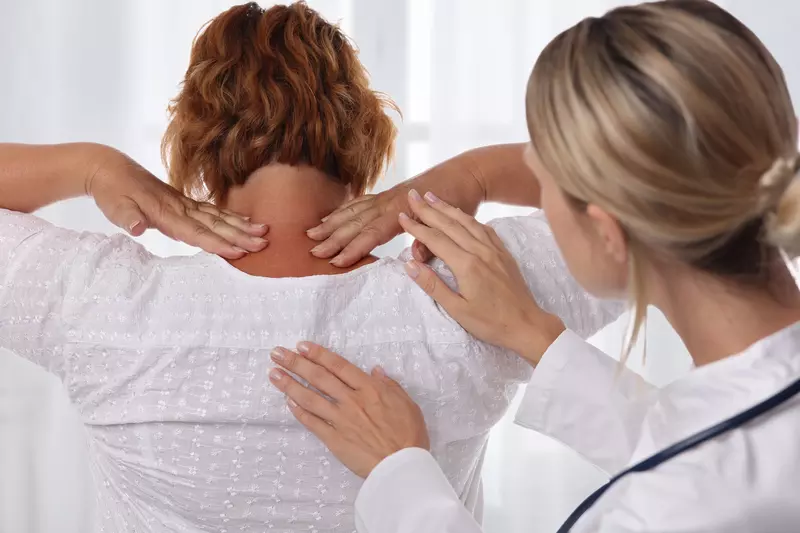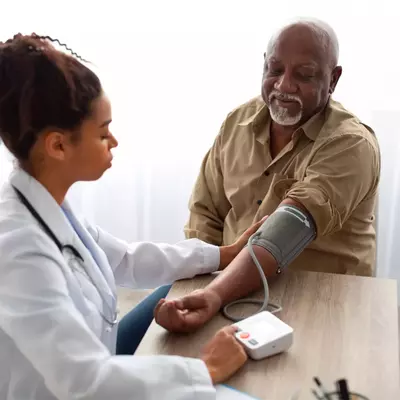- AdventHealth

Many people are apprehensive about acupuncture because they’re nervous about needles or unsure about the benefits of holistic treatment.
Knowing that people have a lot of questions about this therapy, we asked Dr. Emily Mammone, Doctor of Oriental Medicine and Acupuncture Physician at AdventHealth Sports Med and Rehab, to answer some common questions about acupuncture and explain how it complements a life of wellness.
What Is Acupuncture?
Acupuncture is recognized by leading health organizations as a safe, effective treatment for a wide range of medical issues.
“One branch of Chinese medicine is acupuncture. It is thousands of years old and is a holistic approach to healing the body,” explains Mammone.
It involves inserting hair-thin needles into certain acupuncture points (acupoints) on the body to stimulate the body’s natural healing abilities.
What Are Acupoints?
“Acupuncture points are areas of the body that contain many sensory fibers, blood and lymphatic vessels, and nerves. These areas are also known as neurovascular nodes,” Mammone says.
“Studies show that when you insert acupuncture needles in specific acupoints, natural painkillers and oxytocin (also called the “love hormone”) are released. Acupuncture also promotes blood circulation to targeted areas, and good circulation is vital for optimal health,” Mammone explains.
Where Are Acupoints on the Body?
Acupoints can be found everywhere on the body, from the top of the head and out to all four limbs.
“Most acupuncturists work with 365 main acupoints on the body, but there are thousands of acupoints,” Mammone confirms.
How Does Acupuncture Work?
Chronic and acute health issues disturb the body’s ability to maintain internal balance, or homeostasis, Mammone explains. “Acupuncture naturally restores homeostasis in the body, bringing the body back to a state of equilibrium and optimal functioning,” she says.
Acupuncture is healing for a variety of health conditions because it restores the body’s sense of balance.
“Acupuncture works with the nervous system to restore homeostasis in the body, and since the nervous system affects many aspects of the body, acupuncture is effective for a wide range of conditions,” Mammone says.
Is There Anything in Acupuncture Needles?
There is nothing in or on acupuncture needles. “They’re just extremely thin, sterile, disposable needles that are discarded after each patient,” Mammone explains.
There’s nothing particularly special about the needles themselves; they’re merely instruments that stimulate the body’s natural healing abilities.
Will Needles Be Placed in the Area of Pain?
Mammone notes that acupuncture needles don’t have to be placed in the painful area for patients to feel relief.
“If a patient comes in with chronic migraines, I don’t necessarily — most times I don’t — put needles in the head,” she explains. “Instead, I’ll put them in the feet, hands and outside of their area of pain.”
“Similarly, if a patient has lower back pain and their back is sensitive to the touch, I can work with the hands, legs or even the scalp to treat the back pain,” Mammone says.
What Does Acupuncture Treat?
Acupuncture is often associated with pain management, and that’s the top concern Mammone sees among her clients, too. Acupuncture is a natural fit within sports medicine practices as it is highly useful for athletic injuries, stiffness, aches and pains.
Through acupuncture, people can find relief from sports injuries and pain, including lower back pain, stiff neck and knee pain.
You don’t have to be a Michael Phelps or a LeBron James to benefit from acupuncture, though. According to Mammone, acupuncture is also a great option for:
- Allergies
- Anxiety
- Depression
- Digestive issues
- Headache and migraine pain
- Insomnia and other sleep issues
- Post-traumatic stress disorder
- Stress
“Acupuncture is not just for pain,” Mammone says, “it’s effective for emotional conditions as well.” If you struggle with a mental health condition like depression or anxiety, acupuncture could be a powerful addition to your regular treatment plan.
What Can Someone Expect From Their First Acupuncture Experience?
A first acupuncture visit involves a preliminary evaluation followed by treatment. Mammone sits down with each patient to discuss their primary concern for treatment, followed by a thorough health and family history, past surgeries or other major medical health conditions.
The Preliminary Evaluation
After discussing the person’s health history, Mammone and the patient establish what the patient’s main concerns and goals for treatment are, and they’ll set realistic expectations together. Emotional, physical and spiritual health are all addressed in this process.
“It’s a very thorough intake process because I’m not just treating their isolated disease or symptoms, I’m looking at the person as a whole,” Mammone says.
Mammone then does a very specific diagnostic test: an examination of the tongue. “In Chinese medicine, the tongue is a roadmap of the body,” she says. “It gives information about what is going on in the body systemically and where their issue may be stemming from.”
Mammone will also take the patient’s pulse on both sides of their body. “The right- and left-sided pulses give me information about the organ systems and blood circulation.”
The First Treatment Session
After the evaluation, Mammone performs any physical exams as needed while the patient lies on the acupuncture table. “I will use, on average, 20 needles, and the acupoints I choose are specific to what’s going on in their body at that moment,” Mammone says.
With the needles in place, the patient will rest on the table for about 25 minutes. “It’s a very relaxing experience,” she says. “Most patients fall asleep or go into a very deep state of relaxation.”
Once the needles are removed, Mammone goes over a treatment plan with the patient, including an approximation of how many visits they’ll need and the frequency.
Complementary Therapies
If she deems it necessary, Mammone may also do cupping or moxibustion for her patients, in addition to acupuncture.
Cupping is the opposite of a massage, Mammone explains. Instead of pressing down on the tissue, cupping decompresses the tissue. “Wherever there’s an area of pain, there’s a lack of healthy blood flow to that area. With cupping, nutrient-rich blood can nourish that tissue and area of pain.”
Moxibustion is another complementary therapy that Mammone does. Moxa is a Chinese herb, and the type that Mammone uses is condensed into an oil. “I’ll put the Moxa topically on certain acupoints, if it’s a good fit for a patient,” she says. “Moxa can be very beneficial for pain, fertility issues and menstrual problems.”
Are Acupuncture Results Immediate?
For each patient, Mammone makes sure their expectations are realistic, because the focus is on healing the root of the problem. “It takes time for the body to reestablish its optimal state of functioning, and it’s rarely a one- or two-treatment process.”
For conditions like pain, patients will typically feel immediate relief, but it takes time to heal the injury or source of pain. “In most cases, patients will find relief from one or two treatments, but to achieve lasting results, it will take a treatment plan.”
Mammone says there are many contributing factors to how many sessions each patient will need. These include the patient’s age, their overall health, their primary concern for seeking treatment and how acute or chronic their condition is.
“A general rule of thumb is that for every year that you’ve had the issue, it will take one month of acupuncture treatment, coming two or three times a week, but it varies greatly from person to person,” says Mammone.
“Acupuncture is re-training your body to restore balance and function at its best. This can be compared to going to the gym,” Mammone explains. It takes time and consistency to see lasting results, she says.
Why Have Acupuncture Done at AdventHealth Sports Med and Rehab?
Acupuncture is a therapy designed to treat the whole person and not just their symptoms. However, where you have acupuncture done — and with whom — can make a difference in your recovery.
“When patients come in, I’ll examine their whole health, including their lifestyle, diet and emotional health and well-being,” Mammone says.
Mammone takes her time with each patient to put together the best treatment plan for that particular person. “When a patient comes in, they truly have my complete, undivided attention, and they get a very thorough intake and treatment.”
An acupuncture experience is a breath of fresh air from harried doctor visits, too, Mammone says. “People actually love and look forward to coming to acupuncture because it makes them feel so good,” she says.
“Here, they feel listened to and cared for. It really is a very therapeutic experience and patients look forward to seeing the results. Patients often say that they wish they had tried acupuncture sooner.”
Experience Acupuncture at AdventHealth Sports Med and Rehab
We welcome you to try acupuncture with Emily Mammone at AdventHealth Sports Med and Rehab, located inside the Center for Health and Wellbeing in Winter Park. The evaluation includes your first treatment as well — an appointment that lasts about 50 minutes to one hour.
Special Grand Opening Rates
For a limited time only, get an evaluation and your first treatment for $95, and a follow-up treatment for $70.
Hours
Mondays and Wednesdays, from 1:00 – 7:00 pm
Fridays, from 7:00 am – 1:00 pm
Location
AdventHealth Sports Med and Rehab, inside the Center for Health and Wellbeing
2005 Mizell Avenue, Suite 2400
Winter Park, FL 32792
To learn more about acupuncture or schedule your evaluation, call Call407-646-7711, option 3. We’re ready to help you feel whole in body, mind and spirit.



